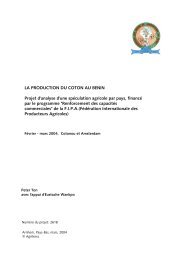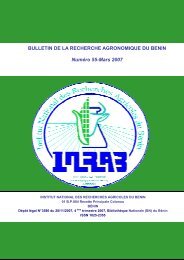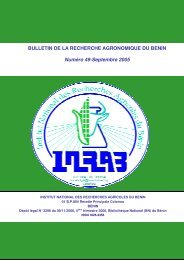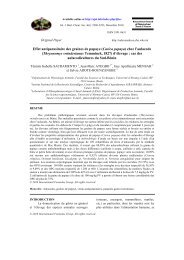Lien externe ou de téléchargement - Slire
Lien externe ou de téléchargement - Slire
Lien externe ou de téléchargement - Slire
- No tags were found...
Create successful ePaper yourself
Turn your PDF publications into a flip-book with our unique Google optimized e-Paper software.
Bulletin <strong>de</strong> la Recherche Agronomique du Bénin Numéro 69 – Juin 2011cope with this situation, they often refer to parents and friends to borrow lands. But, as noticed byMutangadura et al. (1999), the lands they are given are most of the time marginal lands. In addition,Bia<strong>ou</strong> (1996) emphasized that land borrowing as land tenure system is not secure for the borrower,because the land owner can end the contract at any time, especially if he/she gets a betterarrangement (lease or sharecropping systems for example) from someone else. In that case, sale offarm land to borrow from others later is not an efficient and sustainable option for affected h<strong>ou</strong>seholds.Unlike to the study of Haddad and Gillespie (2001), this study did not show an explicit abandonment ofgood farming practices. Also, it was observed that affected h<strong>ou</strong>seholds were likely to diversify theiractivities. They seem to <strong>de</strong>velop a greater interest for livestock production. Another kind of strategyobserved by Gebresselasie (2008) in Ethiopia is the ten<strong>de</strong>ncy of the remaining active members of theaffected h<strong>ou</strong>sehold to work on others’ farms as laborers in or<strong>de</strong>r to get income and supply to theneeds of their h<strong>ou</strong>seholds.CONCLUSIONHIV pan<strong>de</strong>mic represents nowadays a significant challenge for the <strong>de</strong>velopment, because of itsseri<strong>ou</strong>s effects on all livelihoods assets. In rural zones, it affects h<strong>ou</strong>sehold’s available labor, farmedland, yields and income. To mitigate these effects, the affected h<strong>ou</strong>seholds did not remain passive.They <strong>de</strong>veloped vari<strong>ou</strong>s local responses in or<strong>de</strong>r to enhance their farming system and cope with thenew situation. Some of the adjustments they <strong>de</strong>veloped weere: the social reorganization of the farmwork, the rec<strong>ou</strong>rse to hired labor, the favor of home gar<strong>de</strong>ns, the diversification of the activities with afocus on livestock production and the borrowing of farm land. Alth<strong>ou</strong>gh these local responses enablethe affected h<strong>ou</strong>seholds to cope with the situation, they are not actually effective. So, the affectedh<strong>ou</strong>seholds continue to face <strong>de</strong>creasing agricultural production and income. Then, it is necessary toi<strong>de</strong>ntify or <strong>de</strong>velop more appropriate and efficient alternatives, in or<strong>de</strong>r to help these h<strong>ou</strong>seholds toreach sustainable livelihoods. Such work sh<strong>ou</strong>ld be a challenge for agricultural research centers an<strong>de</strong>xtension services.ACKNOWLEDGEMENTSWe are grateful to the International Institute of Tropical Agriculture (IITA) which hosted the research.Thanks to Mr. SHITAWA Francis and Mr. KUPABADO Moses Mananyi for their support during thedrafting of this paper. Finally, <strong>ou</strong>r thanks go to all people involved in this study and particularly theAIDS-affected h<strong>ou</strong>seholds.REFERENCESAdato, M., Meinzen-Dick, R., 2002: Assessing the impact of agricultural research on poverty using the sustainable livelihoodsframework. FNCD Discussion paper 128. International Food Policy Research Institute (IFPRI), Washington, USA.Agbahey, J. U. I., B. J. Gbaguidi, O. N. C<strong>ou</strong>lialy, G. Bia<strong>ou</strong>, 2011: Impact du VIH/SIDA sur les facteurs <strong>de</strong> production et leren<strong>de</strong>ment <strong>de</strong>s ménages agricoles au Sud-Bénin. Bulletin <strong>de</strong> la Recherche Agronomique du Bénin, 69, 17-25.Akrofi, S., P. Struik, L. Price, 2008: Interactive effects of HIV/AIDS and h<strong>ou</strong>sehold headship <strong>de</strong>termine home gar<strong>de</strong>n diversityin the Eastern Region of Ghana. Wageningen J<strong>ou</strong>rnal of Life Sciences, 56(3), 201-217.Asfaw, Z., 2002: Home gar<strong>de</strong>ns in Ethiopia: some observations and generalizations. Proceedings of the 2nd InternationalHome Gar<strong>de</strong>ns Workshop, International Plant Genetic Res<strong>ou</strong>rces Institute, Rome, Italy, 83-96.Bia<strong>ou</strong>, G., 1996 : Etu<strong>de</strong> comparative du fonctionnement du régime foncier dans trois zones agroécologiques du départementdu Mono (République du Bénin). Série d’Economie et <strong>de</strong> Sociologie Rurales, 1996(2), 6-18.Bia<strong>ou</strong>, G., 1993 : Développement du marché <strong>de</strong> la terre sur le Plateau Adja (Bénin). J<strong>ou</strong>rnal of the West African FarmingSystems Network, 3 (2), 54-60.Booysen, F., 2004 : Income and poverty dynamics in HIV/AIDS-affected h<strong>ou</strong>seholds in the free province of S<strong>ou</strong>th-Africa.S<strong>ou</strong>th African J<strong>ou</strong>rnal of Economics vol. 72:3, 522-545.CVG (Commission du VIH/SIDA et <strong>de</strong> la G<strong>ou</strong>vernance en Afrique), 2004 : Effets du HIV/sida sur les mo<strong>de</strong>s <strong>de</strong> subsistanceet la sécurité alimentaire en milieu rural. Actes <strong>de</strong> la Réunion interactive en Ethiopie : résultats <strong>de</strong>s travaux. CVG –Commission économique p<strong>ou</strong>r l’Afrique, Addis-Abeba, Ethiopie, 1-42.DFID (Department for International Development), 2001: Sustainable Livelihoods Guidance Sheets..www.livelihoods.org/info/info_guidanceSheets.html#6Ellis, F., 2000: Rural Livelihoods and Diversity in Developing C<strong>ou</strong>ntries. Oxford University Press, Oxford, UK.Gebreselassie, K., L. Price, J. Wesseler, E. Van lerland, 2008: Impact of HIV/AIDS on lab<strong>ou</strong>r allocation and agrobiodiversity<strong>de</strong>pend on the stage of the epi<strong>de</strong>mic: case studies in Ethiopia. Wageningen J<strong>ou</strong>rnal of Life Sciences, 56(3), 219-240.34
















